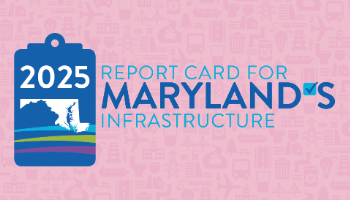Maryland’s Infrastructure Holds Steady at a ‘C’ in 2025 Report Card
The American Society of Civil Engineers (ASCE) Maryland Section has released its 2025 Report Card for Maryland’s Infrastructure, assigning the state an overall grade of ‘C’, unchanged from 2020 and matching the national average. While this grade indicates that Maryland’s infrastructure is performing adequately for current needs, it also signals a pressing need for strategic investment to ensure long-term resilience and reliability.
The report evaluates 13 categories of infrastructure, ranging from roads and bridges to ports and hazardous waste. Notably, Maryland saw improvements in dams, ports, rail, solid waste, and stormwater, while grades for aviation, bridges, energy, and roads declined. For the first time, the report includes an assessment of hazardous waste infrastructure.
Grades by Category
| Grade | Categories |
| B | Ports, Solid Waste |
| B- | Bridges, Rail |
| C+ | Aviation, Hazardous Waste, Stormwater, Wastewater |
| C | Dams, Drinking Water |
| C- | Roads |
| D+ | Energy, Transit |
Highlights from the 2025 Report Card
- Bridges dropped to a B-. Despite being above the national average, Maryland’s aging bridge inventory and the Francis Scott Key Bridge collapse in 2024 underscore the need for resilience and redundancy.
- Roads fell to a C-, with nearly half of major roads in mediocre or poor condition. Traffic congestion costs Maryland drivers $5.6 billion annually.
- Ports improved to a B, with the Port of Baltimore supporting 273,000 jobs and contributing 12% of Maryland’s GDP.
- Energy infrastructure received a D+, down from a C- in 2020. Maryland faces growing energy demand, relies on imports, and has aging generation facilities.
- Water systems—drinking, stormwater, and wastewater—performed better than national averages but still face $10 billion in future needs.
Spotlight on Guest Speakers
The release event featured several influential voices in Maryland’s infrastructure landscape:
- Kishia Powell, General Manager and CEO of WSSC Water, emphasized the need for continued investment. WSSC provides clean and reliable water to nearly two million customers and is the eighth largest water utility in the U.S.
- Luigi Rosa, Amtrak’s VP for the Baltimore and Potomac Tunnel Replacement Project, discussed how ASCE’s report cards shape infrastructure conversations. Rosa highlighted Amtrak’s work to replace the B&P Tunnel, benefiting MARC Commuter Rail and Amtrak’s Northeast Corridor.
Recommendations for Infrastructure Improvement
Establish Sustainable Funding Mechanisms
Transition from fuel taxes to models like vehicle miles traveled, expand user fees, and leverage federal infrastructure programs to close funding gaps.
Prioritize Resilience and Redundancy
Invest in backup capacity, resilient design, and disaster preparedness, especially for bridges, ports, energy, and water systems.
Modernize Aging Systems and Promote Innovation
Upgrade roads, transit, energy, and waste systems to meet the demands of a growing, electrified population. Encourage smart technologies, predictive maintenance, and emerging treatment methods.
Protect the Chesapeake Bay
Coordinate investments in stormwater, wastewater, and drinking water systems to reduce pollution and enhance climate resilience. Prioritize green infrastructure and climate risk assessments.
Strengthen Workforce and Public Engagement
Expand apprenticeship programs, improve public education on dam safety and recycling, and enhance emergency response coordination.
Enhance Coordination and Delivery
Streamline project delivery, consolidate utilities, and adopt alternative procurement methods to reduce costs and improve timelines, especially in transit and rail sectors.
Why Maryland’s Infrastructure Matters
Thanks to all ASCE members who contributed to the 2025 Report Card for Maryland’s Infrastructure and helped launch this vital advocacy tool.
